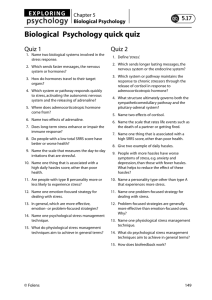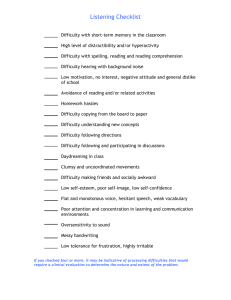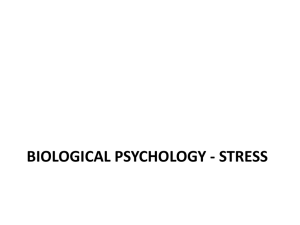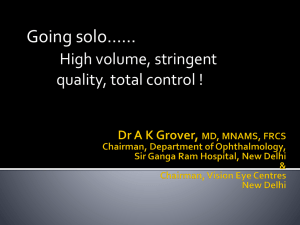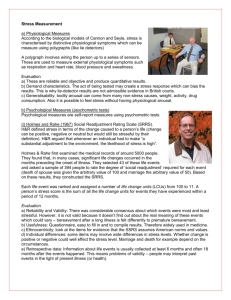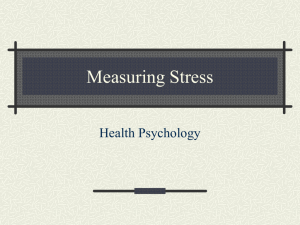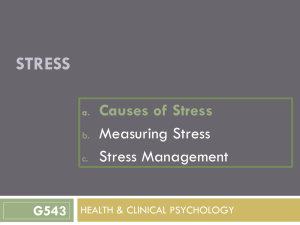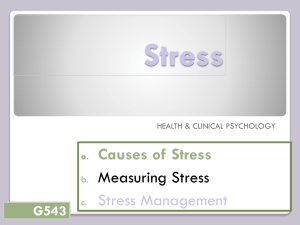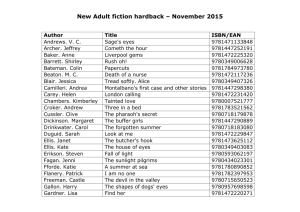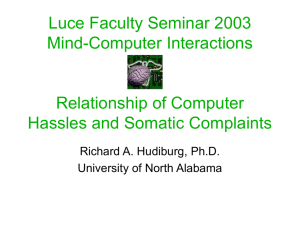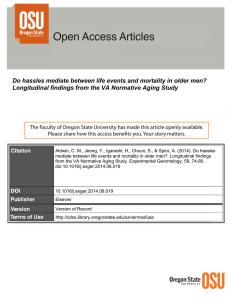Stress 3 - Stanyer Stanyer
advertisement
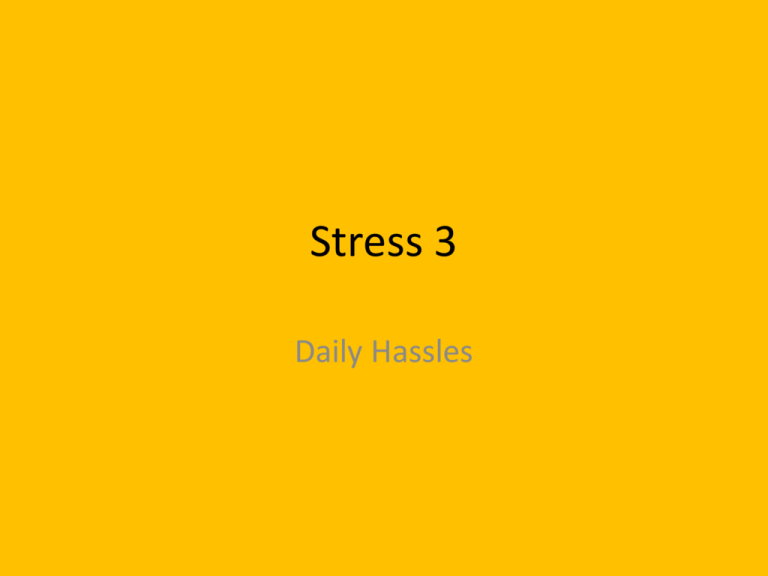
Stress 3 Daily Hassles Syllabus Stress in everyday life 1. Life changes and daily hassles as sources of stress 2. Workplace stress including the effects of workload and control 3. Personality factors, including Type A and Type B behaviour, hardiness 4. Psychological and biological methods of stress management, including stress inoculation therapy and drug therapy Life changes and daily hassles as sources of stress Life events • Think of some. • What is the most stressful. Life events • Think of some. – Marriage, death, moving house, marriage, Christmas? • What is the most stressful. – Death in the family, moving house. Your perception of the stressor, your perceived ability to cope with it Measuring stress • Self report Questionnaires. Quantitative and Qualitative (How stress so you feel). • Example: DASS: depression, anxiety and stress scale • Do not do this. WHY? • Interviews. (trained interviewer) Holmes and Rahe • Life change Units: Asked 394 people to rate 43 life events against marriage. Marriage given a score of 500 and then higher or lower. • Look at saved PDF. Called the Social readjustment rating scale. (SRRS) Problems • USA study - discuss Retrospective analysis People with heart disease and stress related illness given the test. There was a positive correlation. (Rahe and Lind) A prospective study carried out by Rahe et al. Weak positive correlation found. Problems Study used US navy personnel. Causality no association. What is stress related illness? Individual differences. Daily Hassles • Evans and Edgerton • Negative daily events to colds developing. • Look at daily hassles Exam Question Outline and evaluate research into life changes and/or daily hassles as sources of stress. (12) Answer • • • • • Research into life changes can focus on the work of Holmes and Rahe in developing the SRRS as well as into the use of the scale by Rahe et al. Several psychologists have investigated daily hassles as a source of stress, such as Lazarus; Kanner et al; De Longis et al. If daily hassles are described credit can be given to the ideas about frequency, duration and intensity (the accumulation and amplification effects). Credit can be given for a description of theory/model or studies. If studies are used there are different ways of approaching this question. Students can focus on the methodology or findings; they can describe one study in detail or more than one but in less detail. Students can outline either life changes or daily hassles or both, but clearly there will be a breadth/depth trade-off here depending on which way they approach this question. (One in more detail, more than one but in less detail.) NB Examiners should be aware that there is a whole range of studies which can receive credit. AO2: The evaluation can come from a consideration of methodological issues: use of self-report scales, retrospective data, correlations, population validity. Students can also use one to evaluate the other, for example, some psychologists argue that daily hassles are a better predictor of stress-related illness than are life changes. Workplace stress including the effects of workload and control • Environment – workplace, heating, lighting, etc.. • Home-work interface: Work life balance • Control (decision latitude) over their workload. • Workload – too much or even too little. Karasek Model of the relationship between demand (workload), control (decision latitude) and job strain (stress) High Demand Low Demand Low control High strain job (vulnerable to stress) Passive job High control Active Job Low strain job Relationships can be modified by other factors, such as social support. Whitehall studies • Marmot et al. • Whitehall 1: Lower paid = twice the illness and mortality rate. • Whitehall 2 showed similar results with a significant factor being the decision latitude. Issues with experiment • Methodological issues – Based on self-report questionnaires (may have underestimated risk factors such as smoking) – Missing factors (congenital heart problems) – Government Civil servants. • Ethical – Debrief – Support if ill. Lots of studies • There are many studies that have found a similar relationship Fox et al = nurses. Dealing with workplace stress. Measure: The occupational stress indicator (Cooper et al). Then make individual tailored stress management program. Describe one research study that has investigated stress in the workplace. In your answer you should include details of what was done and what was found. Answer Possible research could include Marmot’s research into stress in civil servants; Johansson’s study of Swedish sawmill workers, or any other study of workplace stress. Lee and Denis were talking in the doctor’s waiting room. Denis remarked that his new neighbours were very noisy and that whenever he drove into town it was getting increasingly difficult to find anywhere to park. Lee said that his wife had died recently and that he was just about to retire. Using examples from the conversation above, discuss the difference between life changes and daily hassles. Answer 1 mark for using examples or naming Lee to explain Life Changes and 1 mark for using examples or naming Denis to explain Daily Hassles. For example, Lee is experiencing Life Changes (1 mark). Daily Hassles are things such as the problems with traffic (1 mark). 2 further marks for discussion of the difference. Denis is suffering from frequent, minor, everyday events whereas Lee is suffering from infrequent, major events (2 marks). Credit other psychologically informed elaboration of discussion of difference, for example reference to chronic/acute and links to stress. 3. Personality factors, including Type A and Type B behaviour, hardiness TAB • Friedman and Rosenman - studied people with CHD (coronary heart disease). Decided that people were more susceptible if they had a Type A personality. • Rosenman et al studied over 3000 men allocated them type A or Type B. Followed up and found out of the 257 who had heart attacks 69% were Type A However • Shekelle et al • 12000 males • Found no difference between type A and Type B so not replicated? Hostility • Dembroski et al found that this was closely linked to CHD. • Miller et al supported this through meta review. Hardiness • Kobasa suggested three elements that buffer against stress. • Control • Commitment (the individuals sense of involvement and purpose in life.) • Challenge: opportunity rather stress • Questionnaires used to collect data. • Repeated with similar results Beasley et al. • Type A may have hardiness built in? Type D • Denollet Type D: vulnerable to Heart Disease • D= distressed – high levels of negative emotions and social inhibition. Problems • Self report • Other factors eg: drinking and smoking • Social influences: Ie, poor = poor diet = heart disease • Correlation research association not causality. • Over simplification of personality types. Exam Roy and Mick are members of a football team; both play to the same high standard. Roy never minds if the team does not win; he just enjoys playing with his team-mates and spending time with them after the match. Mick always wants to win and gets angry if the team loses. 3 (a) Which personality type is each person likely to have? • Roy .................................................................................................................................... • Mick ................................................................................................................................... (2 marks) 3 (b) Explain whether Roy or Mick is more likely to suffer from a stress-related illness. Use research in your explanation. (4) Answer 3 (a) Roy = Type B / B / Personality Type B And Mick = Type A / A / Personality Type A (1 mark for each correct answer) 3 (b) It is people with Type A behaviour who are more likely to suffer the negative effects of stress. So in the scenario it is Mick (competitive and angry when loses) who is more likely to suffer from CHD. Friedman and Rosenman research indicated that it is those with Type A who become ill as a consequence of their stress. Type B people such as Roy who doesn’t get physically aroused at losing, are much less likely to experience the “fight or flight” response and so less likely to have raised blood pressure etc. Examiners need to remember that “research‟ can include both theories and studies. For full marks there must be explicit engagement with the stem.
